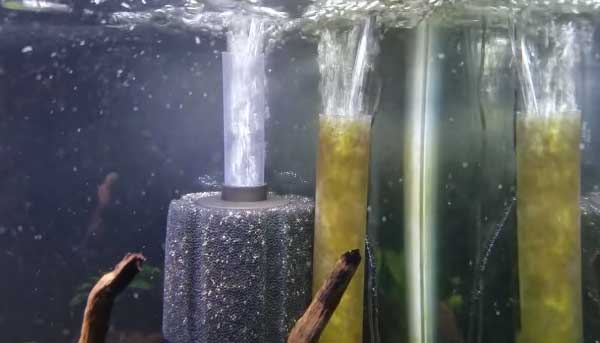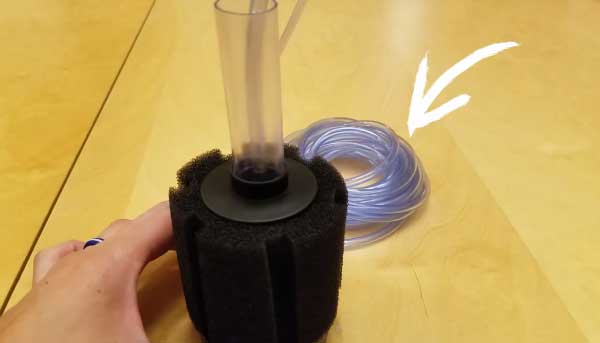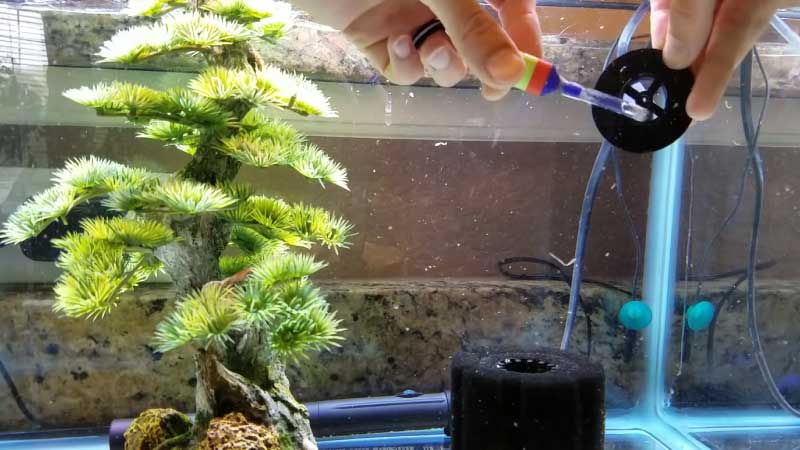A sponge filter is a mechanical and biological filtration device for aquariums. Aquarium sponge filters are designed to trap large pieces of debris and provide a place for beneficial bacteria to colonize. To set up a sponge filter, first, choose an appropriate size for your aquarium.
Sponge filters come in a variety of sizes, so it is important to select one that will fit your tank properly. Once you have chosen the correct size, attach the suction cups that come with the filter to the inside of your aquarium. Be sure to place the sponge filter near the bottom of the tank so that it can effectively remove debris from the water.
Next, connect an air pump to the sponge filter using airline tubing. The air pump will provide oxygenation and flow through the sponge filter which is necessary for proper filtration. Finally, plug in the air pump and watch your new sponge filter begin to work!
How to Install a Sponge Filter + 3 Bonus Tips
- Choose a sponge filter that is the appropriate size for your aquarium
- Rinse the sponge in clean water to remove any debris
- Place the sponge in your aquarium, making sure that it is completely submerged
- Connect an air pump to the sponge filter and turn it on
- Observe the sponge filter to make sure that it is working properly
How to Set Up a Sponge Filter With Air Stone

Sponge filters are one of the most popular types of filters for aquariums and can be used with both fresh and saltwater setups. They are relatively easy to set up and maintain, and are very effective at removing debris and waste from the water. To set up a sponge filter with an air stone, you will need:
- An aquarium sponge filter
- An air stone
- Air tubing
How to Use Sponge Filter Without Air Pump
Sponge filters are a great way to keep your aquarium clean and free of debris. But what do you do if you don’t have an air pump? Can you still use a sponge filter without an air pump?
The short answer is yes, you can still use a sponge filter without an air pump. Sponge filters rely on the movement of water to draw in dirty water and trap particles. So, as long as there is some sort of water movement in your tank, your sponge filter will still work.
There are a few ways that you can create water movement in your tank without an air pump. One way is to use a powerhead. A powerhead is a small submersible pump that creates flow in your aquarium.
You can position the outlet of the powerhead to create the desired flow pattern in your tank. Another way to create water movement is by using an aquarium waterfall or fountain. These devices also don’t require an air pump, and they can add some visual interest to your aquarium as well.
So, if you don’t have an air pump, don’t worry – you can still use a sponge filter! Just be sure to create some sort of water movement in your tank so that the sponge filter can do its job.
How Do Sponge Filters Work

A sponge filter is one of the most popular types of aquarium filters on the market. They are especially popular with beginner fish keepers because they are relatively inexpensive and easy to maintain. But how do sponge filters work?
Sponge filters consist of a piece of foam that is surrounded by a plastic or metal frame. The foam is porous, which means that water can flow through it but small particles are trapped inside. As water flows through the sponge, debris and waste are trapped inside and clean water is expelled back into the tank.
One of the benefits of using a sponge filter is that they provide a place for beneficial bacteria to grow. These bacteria help to break down ammonia and nitrites, which are harmful to fish. The bacteria also help to keep the aquarium water clear by consuming algae and other organic matter.
Sponge filters are easy to set up and use – simply place them in your aquarium and connect them to an air pump or powerhead. They require very little maintenance, although you will need to rinse or replace the sponge occasionally depending on the size of your aquarium and the number of fish you have.
Sponge Filter Kit With Pump
A sponge filter kit with a pump is an aquarium filtration system that uses a sponge to trap debris and waste. The pump circulates water through the sponge, which filters out harmful toxins and bacteria. This type of filtration system is effective at keeping your aquarium clean and free of harmful contaminants.
Best Air Pump for Sponge Filter
A sponge filter is one of the most popular types of filters used in aquariums. They are easy to maintain and provide a high level of filtration. Sponge filters can be used with both fresh and saltwater aquariums.
The best air pump for a sponge filter will depend on the size of your aquarium and the type of fish you have. If you have a small aquarium, you may only need a single-outlet air pump. A good rule of thumb is to choose an air pump that can provide at least double the amount of air than what your aquarium holds.
For example, if your aquarium holds 10 gallons (37.9 L), you will need an air pump that can provide at least 20 gallons (75.7 L) per hour. For larger aquariums or those with more demanding fish, you will need a higher output air pump. The best way to determine the size air pump you need is to look at the manufacturer’s recommendations for your specific sponge filter model.
Generally, it is recommended to choose an air pump that can deliver at least four times the volume of your aquarium each hour. So, if you have a 50-gallon (189 L) tank, you should look for an air pump that can deliver 200 gallons (756 L) per hour. There are many different types and brands of air pumps on the market today.
Some factors you may want to consider when choosing an air pump include: –
- How quiet it is
- The warranty
- What type of power it uses (battery or plug-in)
How Do You Set Up a Sponge Filter for a Tank?

A sponge filter is one of the most popular types of filters for aquariums. They are easy to set up and maintain, and they are very effective at filtering water. Here is a step-by-step guide to setting up a sponge filter for your aquarium:
1. Choose a location for your sponge filter. It should be placed near the bottom of the tank, as this is where most of the debris in the water settles.
2. Place the sponge filter into the aquarium and secure it in place with suction cups or rocks.
3. Connect an air pump to the sponge filter using an airline tubing. The air pump will provide aeration for the water and help to circulate water through the sponge filter. 4. Turn on the air pump and let it run for 24 hours before adding any fish to your aquarium.
This will allow time for bacteria to colonize the surface of the sponge, which will help to break down waste products in your tank’s water.
What Parts Do You Need for a Sponge Filter?
A sponge filter is one of the most basic and essential filters for an aquarium. It is also one of the most versatile filters, as it can be used in a variety of different ways depending on your needs. So, what parts do you need for a sponge filter?
The most important part of a sponge filter is, of course, the sponge itself. The size and type of sponge you need will depend on the size and type of aquarium you have. There are many different types of sponges available on the market, so it is important to choose one that is right for your specific tank.
In addition to the sponge, you will also need an air pump to power the filter. The size and power of the air pump will again depend on the size and type of aquarium you have. Once you have chosen an appropriate air pump, simply connect it to the filter via airline tubing.
Finally, you will need something to support the Sponge Filter. This can be anything from a simple piece of plastic or glass to a more elaborate stand or cabinet. Again, it all depends on your personal preferences and the overall look you are trying to achieve with your aquarium setup.
Can I Run a Fish Tank With Just a Sponge Filter?
One of the most popular questions new fish tank owners ask is “Can I run a fish tank with just a sponge filter?” The short answer is yes, you can! However, there are a few things to consider before setting up your tank with only a sponge filter.
Sponge filters are great for filtering water and providing aeration, but they don’t do much to remove waste or toxins from the water. This means that you’ll need to do more frequent water changes to keep your fish healthy. Sponge filters also don’t provide much surface area for beneficial bacteria to grow, so you may want to add other media, such as ceramic balls or bio-balls, to your filter system.
Another thing to consider is the size of your fish tank. Sponge filters are best suited for smaller tanks (20 gallons or less). If you have a larger tank, you’ll need a more powerful filter system to keep the water clean and healthy.
Overall, sponge filters are a good option for small fish tanks. Just be sure to do regular water changes and add additional filtration media if needed.
Do I Need an Air Stone If I Have a Sponge Filter?
You might be wondering whether you need an airstone if you have a sponge filter in your aquarium. The answer is maybe! It really depends on your specific setup and what other filtration methods you are using.
If you have a larger aquarium with more fish, then you will likely need an air stone to help oxygenate the water. Sponge filters can provide some aeration, but they are not as effective as air stones. In addition, if you have live plants in your aquarium, they will also benefit from the extra aeration provided by an air stone.
On the other hand, if you have a small aquarium with few fish and no live plants, then a sponge filter may be all you need to keep the water clean and filtered. Sponge filters are very low maintenance and can last for years without needing to be replaced. Ultimately, it is up to you to decide whether or not an airstone is necessary for your aquarium.
If you are unsure, it is always best to consult with a qualified aquarium specialist who can assess your specific setup and make recommendations accordingly.
Conclusion
If you’re looking for an easy and efficient way to filter your aquarium water, a sponge filter is a great option. Here’s a step-by-step guide to setting up a sponge filter in your tank:
- Choose a location for your sponge filter. It should be close to an air source, like an air pump or powerhead.
- Attach the air tubing to the outlet on the sponge filter. Make sure the connection is snug and secure.
- Place the sponge filter in your aquarium, making sure that the intake tube is submerged beneath the water line.
- Plug in the air pump or powerhead, and watch as your new sponge filter gets to work!

I’m an aquatic veterinarian have a love for aquarium fish. The purpose of creating this blog is to share my personal experience and expertise with the most popular Betta Fish as well as other fish. If you are, interested in caring for Betta fish species just like me? Follow my articles and guides.
